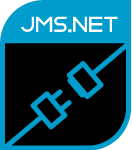Install
Run the installer and select Development installation. This requires Visual Studio. Both 32 and 64-bit components will be installed depending on the platform.
Activate the license
- Launch the JMS Adapter registration tool.
- Click on the Online License Activation tab.
- Copy the activation key from the email we sent you, paste it into the activation key slot, click on the Activate License button.
Launch Visual Studio
Check that the adapter has installed correctly by creating a simple.NET console application and open the Add Adapter Service Reference dialog. Choose the JNBridge JMS Adapter Binding, then open the Configure dialog. This will confirm that the adapter has installed correctly. Use the configuration guides for either ActiveMQ, GlassFish, JBoss, Oracle AQ, SonicMQ, Tibco EMS, WebLogic or WebSphere to enter values for the connection properties.
Connect to the JMS Server
Take a look at the section Tips and Tricks in the Users’ Guide. Follow the section’s advice and work offline using the simple console and generic operations to open a connection to the JMS server and send/receive test messages. Debugging the connection to the JMS Server can then be accomplished by modifying the adapter connection properties in the app.config file generated by the adapter.
Explore more
The Users’ Guide explains how to install, configure, license and use the adapter to build your applications.
The Release Notes contain the latest information about system requirements, recent changes, and known issues.
Guides for JMS Servers how to set up and configure the adapter with the leading web application servers, including ActiveMQ, Glassfish, WebLogic, and WebSphere.
All of these documents are included in your installation.

